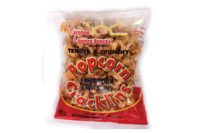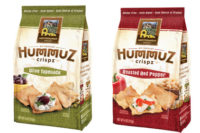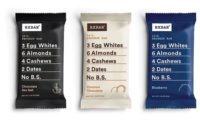Consider this: Some 59% of Americans report making changes to their diet to improve their health, and 69% are trying to lose or maintain their weight, according to a 2011 International Food Informational Council Foundation study. Nine out of 10 Americans, or about 88%, believe that fortified foods and foods with added benefits have at least some impact on overall health.
This research suggests that nutritional, snack, energy, protein and diet bars could actually be the perfect food.
With 55% of consumers snacking at least once a day, and 26% snacking two or more times per day, according to Chicago research firm Technomic’s Snacking Occasion Consumer Trend Report, there is ample opportunity for growth in this segment.
For those offering healthier snack-bar options, there’s even more promise. Technomic reports that 35% of consumers are choosing healthier snacks today, and 27% plan to make even healthier snack choices in the next year.
Clean, cleaner labels
With cleaner labels, a higher level of nutritional content and super foods that provide greater health benefits, manufacturers are making par in this segment.
Recently, there has been an increased focus on cleaner labels that signify products have minimal ingredients.
The focus on healthful eating has created more awareness around topics such as “all-natural,” with the removal of high-fructose corn syrup (HFCS) and partially hydrogenated oils.
“Clean labels are important to consumers, which is causing them to look for specific health claims, such as preservative-free, no artificial flavors or colors and HFCS-free,” says Amanda Osorio, marketing manager, bakery, at J&J Snack Foods Corp., based in Pennsauken Township, N.J.
In its quest for cleaner labels, Rise Bar, located in Escondido, Calif., recently launched a protein bar that includes five ingredients and 17 g. of whey protein. The company’s original bar, launched eight years ago, has three ingredients.
“A typical protein bar contains no fewer than 15 ingredients, so we wanted to simplify it,” says Peter Spenuzza, CEO. “The next trend in bars is to minimize ingredients with cleaner labels.”
The product appeal is geared to females between the ages of 30 and 50, the main demographic for these items. It is those consumers who are looking for a healthy snack that is light and portable to eat in the office or on the go.
Cross pollination
Bars has become a massive category, encompassing diet brands at one end and more indulgent snack bars at the other. Thus, there has been an increase in aisle-hopping with these products. As a result, the segment is experiencing cross pollination between cereal/granola bars and energy/nutrition bars. For example, nutritional and energy bars are being added to breakfast bar shelves as well as being found in health food displays.
“Right now, there is much crossover with brands climbing into aisles for space,” says Peter Wilson, president/CEO of Balance Bar, headquartered in Valhalla, N.Y.
In 2009, when Balance Bar broke off from Kraft, the Bare bar line was rejuvenated with organic sweeteners added to the whole grains, vitamins and mineral content.
“In the past, bars have had a collection of fruits, nuts and sugar that taste great, but are high in calories,” Wilson says. “Now, we’re at a period where these products provide more balanced nutrition.”
Balance Bar recently added a third flavor to its Bare line—blueberry acai—which joins peanut butter and chocolate almond bar varieties. New flavor launches for its Balance Bar line include Chocolate Mint Cookie Crunch, S’mores and Lemon Meringue.
Cleaner labels also speak to the green movement. Because the bar segment has a relatively low barrier to entry, there has been an increase in grass roots businesses that are focusing on sustainability as well as charitable causes.
For example, through a partnership with the International Rescue Committee (IRC), Earnest Eats, located in Solana Beach, Calif., recently introduced a Dark Choco Mint bar created with mint grown and harvested by refugees.
“More and more, this category appeals to cause-related consumers who focus on the origin of foods and farm worker conditions,” Wilson says. “People are becoming more conscious of what they buy.”
‘Bogie’ claims
Just as cleaner labels are on the rise in the bar segment, along with positive claims like added protein, higher fiber and more antioxidants, so are negative claims. Today’s products are more apt to be free of sugar, gluten, soy, artificial ingredients, high-fructose corn syrup, additives, preservatives and other less desirable components.
Kind Healthy Snacks, New York City, has lowered the sugar content of its bars to 5 g. or less by replacing fruit with spices, including ginger and cinnamon. Like its other products, the Kind Nuts & Spices line includes all-natural ingredients that are visible.
“Today’s consumers are voicing a demand forlower sugar snacking options,” says Kind’s president John Leahy. “While our existing line of whole-nut and fruit bars contains only a moderate amount of natural sugars found in fruits and honey, we also wanted to expand our offering to meet the needs of consumers looking to lower their sugar intake even further.”
In many bakery and snack segments, including bars, gluten-free has become a synonym for ‘healthier.’
“Even though there are only about 3 million people with gluten allergies, it’s reported that this is diagnosed only between 1 and 3% of the time,” Spenuzza says. “As a result, this demographic will grow substantially. Especially as taste technology improves with gluten-free bars, we will see more innovation in this category.”
Super food
Bars have become the delivery vehicle for functional ingredients, many of which are considered super foods. These can range from fruits like acai and pomegranate to grains like quinoa and amaranth and nutrients including CoQ10, L-carnitine, Omega 3, resveratrol and vitamin K2.
“Still, probiotics were trending up but are now decreasing in popularity, since government regulations have come into play,” points out Eric Kimmel, owner of Noble Foods Inc., a bar co-packer located in Quebec, Canada.
Rise Bar was one of the first bar companies to offer superfruit in an energy bar form with the addition of acai and pomegranate to its lines.
“Superfruits have been around since 2000, and since then the antioxidant effects of these foods has been well-documented,” Spenuzza says. “We’ve been able to incorporate these fruits into great-tasting bars.”
Earnest Eats is pushing super food ingredients further with its bar products. The company offers a chewy granola line with quinoa and amaranth that is low in sugar and a dark chocolate almond line that contains power grains and flax.
“It can be difficult for bar manufacturers, because if a product is not sweet enough, people reject it,” says Andrew Aussie, co-founder and president of the company. “Yet, if the bar is too sweet, consumers will notice the grams of sugar. The conundrum is how do we deliver the sweetness people demand while incorporating less sugar?”
Because people are now paying more attention to labels and ingredients, this is a prime opportunity to tout the nutritional benefits of bar ingredients. Repositioning these products has helped propel bars from afternoon snacking to a morning breakfast item and even lunch meal replacement.
“Our bars have superfruits and nuts that can be eaten in the morning or throughout the day,” says Lizanne Falsetto, founder and CEO of Think Thin Products, located in Santa Monica, Calif. “When people realize they can have a nutrition bar with a daily dose of protein and fiber, they will reach for the healthier products that fall under our platform—weight and wellness.”
The nutrient awareness will only become more prominent, as the younger generation becomes more educated on health and nutrition.
In addition, the evolution of technology, added creativity of manufacturers and on-trend products all point to a continuing growth pattern in the bar segment.
“Innovation comes from flavor profiles, and there is more of a widespread palate for salty and savory bars,” Falsetto says. “The combination of ingredients has been thought through. There’s a lot of creativity, with candy flavors being incorporated into nutrition bars.”
A snack on the back nine
In the past, bars were full of calories ingredients people were unfamiliar with. But as consumers have become more educated about whey protein, antioxidants, fiber and other beneficial ingredients, taste continues to trump nutrition when it comes to bar preferences.
This has led to the popularity of more indulgent bars, including Mars Chocolate North America’s Kudos line. Capitalizing on the popularity of its chocolate brands, the offerings now include Kudos Snickers Peanuts with 20% more peanuts, Kudos M&M’s Milk Chocolate Candies with an improved chocolate taste and the launch of Kudos Dove Chocolate Drizzle.
The company’s Marathon energy and protein bar brand has focused on consumers who are trying to keep active in enjoyable ways.
“For nutrition bars, the decision process is typically nutritional first, protein or energy, then flavor,” says Tim Quinn, vice president of trade development for the Hackettstown, N.J.-based company. “Flavor fatigue is common within the energy/nutrition bar category, so consumers develop a range of flavor choices that deliver the appropriate levels of nutrition.”
Cashmere, Wash.-based Liberty Orchards is another confectioner that has entered the health bar segment. It seemed like a natural extension to its fruit and nut candy lines.
“These newer nutrition bars taste better than the first generation of products that have been available in this category for a while,” says Greg Taylor, president of the company. “We see continued growth in natural, wholesome and nutrition-rich bars that taste good.”
The company’s Orchard Bar line, introduced two years ago, is sweetened with organic tapioca syrup and real apple concentrate. Last winter the company launched a banana mango macadamia bar and cherry almond crunch bar.
Targeting those looking for functional food that tastes good, RezVez in Rancho Santa Fe, Calif., offers Wine Time Bars, which have the taste elements of a candy bar, but ingredients that are proven heart-healthy and anti-aging.
“We identified Wellmune, a yeast extract with scientific evidence of boosting immune systems,” says Malcolm Nicholl, the company’s president and CEO.
The bars, which are free of gluten and dairy, high in fiber and low in calories, offer the benefit of more than 50 glasses of red wine, though without the effects of alcohol.
“Instead of popping a pill, the aging population wants functional nutrition that they can eat,” Nicholl says.
Packaging updates
Similar to what has occurred in the candy bar segment, multipacks and mini sizes are growing in the bar category.
“We think mini bars or bars smaller than 40 or 50 g. will be on cue soon,” Wilson says. “It seems 50 g. is too much for those looking for light snack. We offer a 25-g. bar that we position as a lighter snack or lunch box item.”
These true snack sizes appeal to females who are watching their calories as well as mothers who are purchasing bars for their children.
Due to increasing demand, Earnest Eats is launching a chewy granola bar in a snack size.
“There is a desire for smaller snack-size formats, which has increased the popularity of multi packs,” Aussie says. “It used to be single-serve bars were all that was available, but now there is more demand for pantry packs to share.”
In July 2011, responding to consumers looking for a smaller-sized bar, J&J Snack Foods introduced READI-BAKE BeneFIT 1.25 oz. Mini Bars, an extension of the company’s original 2.5 oz. BeneFIT Bar line. Cranberry orange, maple brown sugar and oatmeal spice flavors are available.
“Ten years ago, almost all of these products were sold by the bar,” Kimmel says. “Now, many bars are trending more toward boxes of five, six and seven. This forces the price down, despite the fact that more functional ingredients are stuffed inside. That’s a challenge for manufacturers.”
With the increased emphasis on health, nutrition and cleaner labels, some manufacturers have revamped packaging to make the bar more visible to consumers.
“Bars are packaged in clear wrap so consumers can see the ingredients,” Aussie says. “It’s one thing to talk about whole food ingredients, but consumers want to see what they’re buying. The oats and almonds need to stick out.”
When Kind helped pioneer transparency in healthy snacking back in 2004 with the introduction of its all-natural snack bar, it incorporated transparent wrappers.
“In support of our ingredient transparency, we use clear packaging on all our products, so as to show consumers that what you see is what you get,” Leahy says.
Balance Bar’s Bare line also showcases the bar within the wrapper to emphasize its brand messaging.
Along with the popularity of clear wrappers, windows on boxes also are popping up more often.
Looking ahead, continued innovation, updated flavor profiles and nutritious ingredient additions will keep bar category growth steady.
In the next few years, Wilson says there will be a robust battle for consumers’ attention. “Flavor trends come and go. It’s balanced and quality nutrition that people gravitate towards with these products.”
Capitalizing by Crossing Over |
|
Jason Cohen, cofounder of Rickland Orchards in Fairfield, N.J., was aware of nutrition bars containing whey protein, calories and ingredients in which “people didn’t know what the function was.” After witnessing the rocket-ship growth of Greek yogurt, he, along with cofounder, Michael Sands, came upon a revolutionary idea to marry two healthy products. The result was the creation of all-natural Greek yogurt bars, which hit the market last February and at press time had already received more than 10,000 store authorizations. “Our whole concept is about moving one category into another,” Cohen says. “It can be a lot of work to digest the bars on the market. This line offers the benefits of protein and the digestive advantages of Greek yogurt.” The 160-calorie bars have 7 g. of protein and 5 g. of fiber, in addition to the probiotics provided by authentic Greek yogurt. “Buyers tell us we are bringing new users into the category with this line,” Cohen says. Cohen has a history of building brands and introducing innovative items into mature categories. He was the creator of Sensible Portions Veggie Straws, now owned by World Gourmet. This product added vegetables to a chip-type snack. The new bar line flavors lend to what people mix in morning, including blueberry acai, cherry almond, cranberry almond, peach, apple cinnamon and coconut. The yogurt is sourced from European dairies in an effort to stay true to the Greek style. “I’m hearing that bars are adult-driven, and many have a strong whey protein flavor that doesn’t appeal to kids,” Cohen says. “That’s not the case with our line.” |









